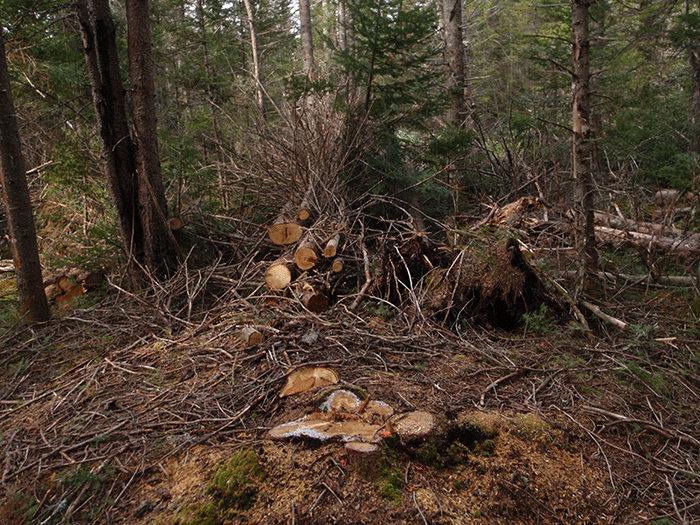In Protect the Adirondacks v NYS Department of Environmental Conservation, the Appellate Division, Third Department, reverses lower court with a 4-1 decision affirming past precedents for the protection of the “forever wild” Forest Preserve and finds state tree cutting of more than 25,000 trees to be unconstitutional
The Appellate Division, Third Department, ruled today that state tree cutting to build a network of wide class II community connector snowmobile trails in the Adirondack Forest Preserve violated Article XIV, Section 1 of the State Constitution. The Appellate Division, Third Department, reversed a lower court ruling issued in 2017. Protect the Adirondacks had challenged the constitutionality of cutting more than 25,000 trees to build over 27 miles of new snowmobile trails in the Forest Preserve. The lawsuit was started in 2013, injunctions against further tree cutting were ordered in 2016, and a bench trial was held at State Supreme Court in 2017.
Article XIV, Section 1, of the New York Constitution, states, in relevant part, that “[t]he lands of the state, now owned or hereafter acquired, constituting the Forest Preserve as now fixed by law, shall be forever kept as wild forest lands. They shall not be leased, sold or exchanged, or be taken by any corporation, public or private, nor shall the timber thereon be sold, removed or destroyed.”
Click here to read the court decision.
This is a great day for the public forever wild Forest Preserve. This is a major decision in the history of the Forest Preserve and protections in Article 14, Section 1, of the State Constitution. The 3-million acre Forest Preserve is the finest state-owned public lands system in the United States and has been protected and expanded through a multi-generational, bipartisan commitment of New Yorkers for over 130 years. The Appellate Division, Third Department, decision is a major victory because the court ruled that the level of tree cutting necessary to build a network of road-like trails constituted an unconstitutional destruction of timber on the Forest Preserve.
The decision focused on two central points that were contested during the 2017 trial: 1) that the level of tree cutting by the state to build class II trails exceeded the level of tree cutting proposed in other state actions that were contested in court in prior decisions (MacDonald, Balsam Lake) regarding Article XIV, Section 1. 2) That the framers of the state constitution’s “forever wild” clause did not limit protections against substantial tree cutting to only large, merchantable “timber;” that the use of the word “timber” in its historic context included all trees regardless of size; that small trees, which can often be over 75 years old or older, are ecologically important to the functioning of the forest ecosystem and must be considered in state management decisions.
The court stated:
We agree with Supreme Court’s determination, based on the expert historian’s testimony as well as other evidence, that the use of the word “timber” in the constitutional provision at issue is not limited to marketable logs or wood products, but refers to all trees, regardless of size. Although tree size and maturity may be considered in determining whether a proposed project’s tree cutting is substantial or material, plaintiff presented expert testimony debunking the assumption that smaller trees are necessarily young or immature; some forest trees measuring less than three inches DBH can be more than 100 years old, and smaller mature trees play an important role in the continuing ecology of the forest. The court generally accepted the tree counts proffered by plaintiff, including for trees less than three inches DBH. Accepting those factual findings, approximately 25,000 trees either had been or would be cut to construct the trails.
The court concluded:
Although this project did not involve clear-cutting or the removal of a large swath of trees (compare Association for Protection of Adirondacks v MacDonald, 253 NY at 236), but instead necessitated destruction of narrow corridors of trees for many miles, we need to consider the entire project when determining its effects. The destruction of a substantial number of trees can be problematic whether those trees were together or spread out along one or more portions of the Forest Preserve. For example, the construction of these trails required the destruction, on average per mile, of over 200 trees at least three inches DBH and approximately 925 trees of all sizes. It would be anomalous to conclude that destroying 925 trees per mile of trails, or approximately 25,000 trees in total, does not constitute the destruction of timber “to a substantial extent” or “to any material degree” (id. at 238; see 1954 Ops Atty Gen 157 [concluding that the constitutional provision prohibits relocating a portion of existing highway in the Forest Preserve that would involve the cutting of approximately 5,000 trees]). Thus, the construction of the Class II trails resulted in, or would result in, an unconstitutional destruction of timber in the Forest Preserve.
The constitution does not provide protections to some trees but not to others. It provides protections to all trees. State agencies have been allowed to undertake any number of management activities on the Forest Preserve in order to maintain and protect it and provide for public recreational activities, provided that the destruction of timber does not occur “to a substantial extent” or “to a material degree.” The court found that cutting of 25,000 trees to build a network of class II trails violates longstanding policy and is unconstitutional.
The Cuomo Administration has made the expansion of motor vehicle use of the Forest Preserve one of its biggest priorities in the Adirondack Park. Hopefully, this decision today will put the brakes on the Governor and state agencies. There are a wide variety of public recreational activities that can be facilitated on the Forest Preserve, but must be managed in a way that complies with the State Constitution and the forever wild protections.
Click here to read the court decision.






